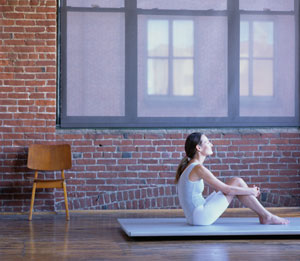Feel Better at Work, The Pilates Way
- Published: Wednesday, March 9th 2011
- in Fitness
 It is a familiar modern requirement: Do more work in fewer hours. Never has it been more necessary to work smarter, not harder.
It is a familiar modern requirement: Do more work in fewer hours. Never has it been more necessary to work smarter, not harder.
Perhaps this is one of the reasons Pilates is still one of the fastest-growing exercise techniques and is resonating with the overworked. It is not so much about repetition of movement as it is the quality of movement. “A few well-designed movements, properly performed in a balanced sequence, are worth hours of doing sloppy calisthenics or forced contortion,” said Pilates founder Joseph Pilates, who developed the method in the 1920s.
So with a program that has approximately 500 exercises in its repertoire, often performed on a combination of mats and machines, how can we apply its principles during our time at the office? We spoke to Ernie Fossa, owner and founding partner of New York City’s Gramercy Pilates Fitness, one of our Wellness Week™ participating studios. No stranger to high-pressure work, Fossa left the stressful world of advertising nine years ago to pursue his new healing path as a Pilates instructor. Fossa shared several ways Pilates can relax us, keep us aligned, and help us be more efficient at the office.
Pilates aware = body aware. Since a key focus of Pilates is body alignment, a regular Pilates practice helps you become more educated about your posture. “A lot of people don’t even realize they’re slouched over at their computers,” says Fossa. “When you learn Pilates principles and some of its alignments, preferably in a Pilates studio, you become mindful of being in bad positions, and you’re much more able to readjust your body.”
Take a mat break instead of a coffee break. If you can find an empty conference room, or if you have enough space in your office, bring your Pilates mat to work so you can do some stretches during short breaks throughout your day. Doing so will connect you to your breath and promote better alignment when you return to your desk. For a sore lower back, he recommends doing several classic yoga stretches (which are often incorporated into Pilates): cat, cow, and child’s pose.
Employ a small rubber ball as your massage therapist. In his studio, Fossa often encourages his clients to use pinkie balls (hard rubber Spaldeens will work) for self-massage so they can release fascia. Fascia is a fibrous connective tissue found throughout the body that supports muscles—along with other organs—which can also constrict due to tension and/or trauma. “Releasing fascia helps my clients perform their Pilates exercises better. It’s the same thing for when you’re at work, and you’re very tight. If you release fascia in your body, you’re going to feel better sitting at your desk.”
If you want to release fascia in the upper back, for example, he recommends leaning against a wall, and setting the ball between your scapula and spine. Then gently move side to side and up and down to detect any knots. If you find one, just rest on it, and breathe into it. You can also roll out the fascia at the bottom of your feet—not only does doing so feel great, but you can also do this at your desk.
Practice conscious breathing. “Breathing is a great way to release stress,” says Fossa. “Think about where you’re breathing and where you’re not breathing.” Pilates practices three-dimensional breathing. Inhale and imagine the ribs expanding forward, sideways, and backward as you fill your upper chest, lungs, diaphragm, and back with oxygenated air. When you exhale, visualize the air releasing in the opposite direction. Empty from the upper chest, downward. This deep exhalation also activates the abdominal muscles, which are essential to stabilization and posture. Repeat this conscious breathing until you feel calm enough to return to your tasks with more focus and energy.
Gramercy Pilates Fitness in Manhattan will be offering boot camp, private training and classes for four during Wellness Week™. To find out where to practice Pilates in your area once the big week arrives, sign up for Wellness Week™ news and alerts.



